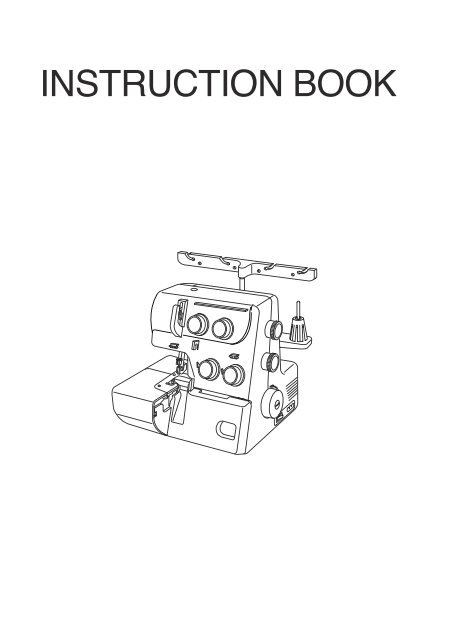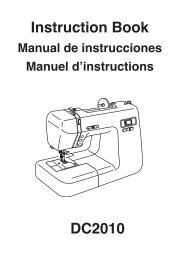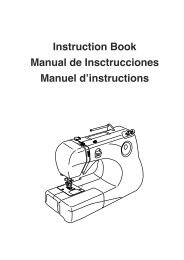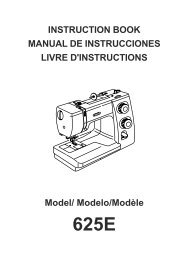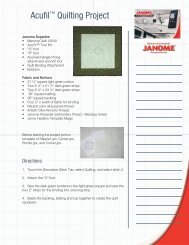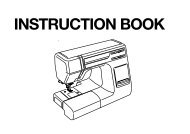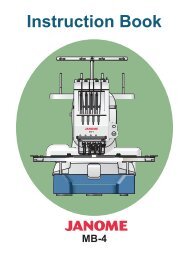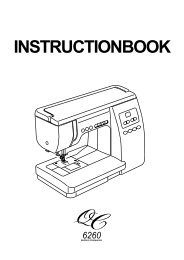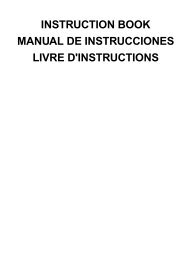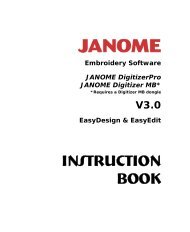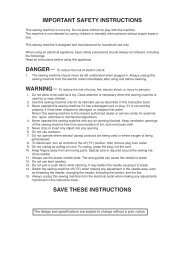Create successful ePaper yourself
Turn your PDF publications into a flip-book with our unique Google optimized e-Paper software.
INSTRUCTION BOOK
IMPORTANT SAFETY<br />
INSTRUCTIONS<br />
Your sewing machine is designed and constructed only for HOUSEHOLD use.<br />
Read all Instructions before using this appliance.<br />
DANGER – To reduce the risk of electric shock:<br />
1. An appliance should never be left unattended when plugged in. Always unplug this appliance from the<br />
electrical outlet immediately after using and before cleaning.<br />
2. Always unplug before relamping. Replace bulb with same type rated 15 Watts.<br />
3. Do not reach for the appliance that has fallen into water. Unplug immediately.<br />
4. Do not place or store appliance where it can fall or be pulled into a tub or sink. Do not place in or drop<br />
into water or other liquid.<br />
WARNING – To reduce the risk of burns, fire, electric shock,or injury to persons.<br />
1. Do not allow to be used as a toy. Close attention is necessary when this appliance is used by or near<br />
children.<br />
2. Use this appliance only for its intended use as described in this manual.<br />
Use only attachments recommended by the manufacturer as contained in this manual.<br />
3. Never operate this appliance if it has a damaged cord or plug, if it is not working properly, if it has been<br />
dropped or damaged, or dropped into water. Return the appliance to the nearest authorized dealer or<br />
service center for examination, repair, electrical or mechanical adjustment.<br />
4. Never operate the appliance with any air opening blocked. Keep ventilation openings of the sewing<br />
machine and foot controller free from accumulation of lint, dust, and loose cloth.<br />
5. Never drop or insert any object into any opening.<br />
6. Do not use outdoors.<br />
7. Do not operate where aerosol (spray) products are being used or where oxygen is being administered.<br />
8. To disconnect, turn all controls to the off (“ 0 ”) position, then remove plug from outlet.<br />
9. Do not unplug by pulling on cord. To unplug, grasp the plug, not the cord.<br />
10. Keep fingers away from all moving parts. Special care is required around the sewing machine needle<br />
and knives.<br />
11. Always use the proper needle plate. The wrong plate can cause the needle to break.<br />
12. Do not use bent needles.<br />
13. Do not pull or push fabric while stitching. It may deflect the needle causing it to break.<br />
14. Switch the sewing machine off (“ 0 ”) when making any adjustment in the needle area, such as<br />
threading needle, changing needle, threading loopers, or changing presser foot, and the like.<br />
15. Always unplug the sewing machine from the electrical outlet when removing covers, lubricating, or<br />
when making any other adjustments mentioned in the instruction manual.<br />
SAVE THESE INSTRUCTIONS<br />
1
Do’s and Don’ts<br />
1. Always be aware of the up-and-down movement of the needle and do not turn your attention<br />
away from the machine while it is running.<br />
2. When leaving the sewing machine unattended, the main switch of the machine must be<br />
switched off or the plug must be removed from the socket-outlet.<br />
3. When servicing the sewing machine, or when removing covers or changing lamps, the machine<br />
must be disconnected from the power supply by removing the plug from the socket-outlet.<br />
4. Do not place anything on the foot control, otherwise the machine will start inadvertently, or the<br />
control or motor may burn out.<br />
5. The maximum permissible power for the sewing lamp bulb is 15 watts.<br />
6. When using your sewing machine for the first time, place a piece of waste fabric under the<br />
presser foot and run the machine without thread for a few minutes. Wipe away any oil which<br />
may have appeared.<br />
2
TABLE OF CONTENTS<br />
PREPARATION<br />
Names of Parts...................................................4<br />
Standard Accessories ........................................4<br />
Connecting the Machine to the Power Supply...... 5<br />
Controlling Sewing Speed ................................. 5<br />
For Your Safety ..................................................5<br />
How to turn the Handwheel ............................... 6<br />
Opening and Closing the Side Cover ................ 6<br />
Opening and Closing the Looper Cover ............ 6<br />
The Position of Thread Guide Bar...................... 7<br />
Attaching the Spool Holder Cap and Net ............. 7<br />
Changing Needle................................................8<br />
Raising or Lowering the Presser Foot ................ 8<br />
Removing the Presser Foot................................ 9<br />
Attaching the Presser Foot ................................ 9<br />
Adjustment of Foot Pressure .............................9<br />
Adjustment of Stitch Length ............................10<br />
Adjustment of Differential Feed Ratio .............. 10<br />
To Deactivate the Upper Knife .........................11<br />
To Activate the Upper Knife .............................11<br />
Adjustment of Cutting Width ............................12<br />
Adjustment of Needle Plate Setting Knob .......13<br />
Threading the Machine ............................. 14~23<br />
• Threading the Lower Looper .................... 15<br />
• Threading the Upper Looper .................... 18<br />
• Threading the Needle on the Right........... 20<br />
• Threading the Needle on the Left ............. 22<br />
TEST STITCHING<br />
Starting Sewing ................................................24<br />
Finishing Sewing ..............................................24<br />
Sewing Continuously .......................................24<br />
How to use Guide Lines ................................... 24<br />
Securing Ends ..................................................25<br />
Thread Tension (4 threads) ..............................26<br />
Threading the Machine (3 threads) ..................28<br />
Thread Tension (3 threads) ..............................29<br />
Thread and Needle Chart .................................30<br />
ROLLED HEMMING, PICOT EDGING AND<br />
NARROW HEMMING<br />
Machine Setting and Thread, Fabric and<br />
Range of the Tension Dial ................................31<br />
Thread Tension ................................................32<br />
For Better Results ............................................33<br />
DECORATIVE OVEREDGING<br />
Thread and Fabric ............................................34<br />
Machine Setting ...............................................34<br />
GATHERING<br />
Thread and Fabric ............................................34<br />
Machine Setting ...............................................34<br />
PIN TUCKING<br />
Thread and Fabric ............................................35<br />
Machine Setting ...............................................35<br />
Sewing ..............................................................35<br />
CARE OF YOUR MACHINE<br />
Replacing the Upper Knife ...............................36<br />
Cleaning Upper Knife Area...............................36<br />
Replacing the Light Bulb ..................................37<br />
Cleaning the Feed Dog ....................................37<br />
Oiling the Machine ...........................................38<br />
Carrying the Machine .......................................38<br />
Troubleshooting ...............................................39<br />
OPTIONAL PARTS ........................................ 40<br />
3
PREPARATION<br />
2<br />
17<br />
1<br />
5<br />
15 16<br />
14<br />
13<br />
12<br />
11<br />
10<br />
Names of Parts<br />
1 Left needle thread tension dial<br />
2 Right needle thread tension dial<br />
3 Upper looper thread tension dial<br />
4 Lower looper thread tension dial<br />
5 Side cover<br />
6 Looper cover<br />
7 Handwheel<br />
8 Power switch<br />
9 Machine socket<br />
3<br />
4 6<br />
9<br />
8<br />
7<br />
10 Differential feed dial<br />
11 Stitch length dial<br />
12 Spool stand<br />
13 Spool holder<br />
20<br />
18<br />
14 Spool pin<br />
15 Thread guide bar<br />
21<br />
22<br />
19<br />
16 Thread guide<br />
17 Pressure adjusting screw<br />
18 Presser foot<br />
23<br />
19 Needle plate setting knob<br />
20 Thread cutter<br />
24<br />
21 Presser foot lifter<br />
22 Needle plate<br />
23 Upper knife release knob<br />
27<br />
25<br />
24 Cutting width adjusting dial<br />
25 Upper looper<br />
26<br />
26 Lower looper<br />
27 Upper knife<br />
28 Lower knife<br />
28<br />
Standard Accessories<br />
1 Screwdrivers<br />
2 Tweezers<br />
3 Set of needles<br />
1 2 3<br />
4
3<br />
4<br />
5<br />
Connecting the Machine to the Power Supply<br />
Before connecting the machine to the power supply,<br />
make sure the voltage and frequency shown on the<br />
machine conform to your electrical power.<br />
1<br />
2<br />
2<br />
1. Turn off the power switch, and connect the<br />
machine plug to the machine socket.<br />
2. Connect the power supply plug to your power<br />
supply.<br />
3. Turn on the power switch.<br />
1<br />
3<br />
1<br />
6<br />
1 Power switch<br />
2 Machine plug<br />
3 Machine socket<br />
4 Power supply plug<br />
5 Power supply<br />
6 Speed controller<br />
Controlling Sewing Speed<br />
Sewing speed can be varied by the speed controller.<br />
The harder you press on the controller, the faster the<br />
machine runs.<br />
Step on the speed controller with the presser foot<br />
lifter up, and practice controlling the speed.<br />
1<br />
1 Speed controller<br />
For Your Safety:<br />
* While in operation, always keep your eye on the<br />
sewing area, and do not touch any moving parts<br />
such as the thread take-up lever, loopers,<br />
handwheel, needle or knives.<br />
* Always disconnect the machine from the power<br />
supply:<br />
— when leaving the machine unattended.<br />
— when attaching or removing parts.<br />
— when threading or cleaning the machine.<br />
* Do not place anything on the foot control,<br />
otherwise the machine will start inadvertently.<br />
5
How to turn the Handwheel<br />
Always turn the handwheel toward you (Counterclockwise).<br />
1 Handwheel<br />
1<br />
Opening and Closing the Side Cover<br />
1<br />
To open:<br />
Push the side cover to the left.<br />
To close:<br />
Push the side cover to the right.<br />
1 Side cover<br />
B<br />
1<br />
A<br />
Opening and Closing the Looper Cover<br />
To open: A<br />
While pushing with the thumb to the right as far as it<br />
will go, pull the looper cover toward you.<br />
To close: B<br />
Lift the looper cover and push it against the<br />
machine.<br />
The looper cover snaps into its position<br />
automatically.<br />
1 Looper cover<br />
Note:<br />
Always close both side cover and looper cover<br />
when the machine is in use.<br />
6
2<br />
1<br />
The Position of Thread Guide Bar<br />
1. Pull the thread guide bar up as far as it will go.<br />
2. Turn the thread guide bar so that the thread<br />
guides are right above the spool pins.<br />
3<br />
4<br />
1 Thread guide bar<br />
2 Thread guide<br />
3 Stoppers<br />
4 Spool pin<br />
* Make sure to lock the thread guide of guide pole<br />
in the correct position with the two stoppers.<br />
1 2<br />
1<br />
3<br />
4<br />
2<br />
Attaching the Spool Holder Cap and Net<br />
(Optional)<br />
1. When you use a small thread spool, pull out the<br />
spool holder from the spool pin. Then place the<br />
spool with its slit side up, and put the spool<br />
holder cap on top of it.<br />
1 Spool holder<br />
2 Spool pin<br />
3 Spool holder cap<br />
4 Slit<br />
1<br />
2<br />
2. If the thread slips down from the spool<br />
during threading and/or sewing, put a net on the<br />
spool as illustrated to prevent jamming.<br />
* The spool holder cap and net are optional<br />
accessories.<br />
1 Net<br />
2 Spool pin<br />
1<br />
2<br />
7
Changing Needle<br />
1<br />
Turn off the power switch and unplug the machine.<br />
Raise the needle to its highest position.<br />
Then loosen the left or right needle clamp screw for the<br />
needle you are going to remove.<br />
2<br />
1 Needle clamp screw on the left<br />
2 Needle clamp screw on the right<br />
* Use HA-1SP #14 Needle or #11.<br />
5<br />
4<br />
3<br />
1<br />
2<br />
4<br />
To attach the needle on the right :<br />
Insert a new needle into the needle clamp with the<br />
flat side to the back until the top of the needle<br />
touches the stopper pin, then tighten the needle<br />
clamp screw on the right.<br />
6<br />
6<br />
To attach the needle on the left :<br />
Insert a new needle into the needle clamp with the<br />
flat side to the back until the top of the needle<br />
touches the edge of the needle bar, then tighten the<br />
needle clamp screw on the left.<br />
* When the needles are set correctly, the left<br />
needle is higher than the right one.<br />
* Use HA-1SP #14 Needle or #11.<br />
1 Needle clamp<br />
2 Needle<br />
3 Needle stopper pin<br />
4 Edge of needle bar<br />
5 Needle clamp screws<br />
6 Flat side to the back<br />
* Do not use any needle which is bent or blunt.<br />
Raising or Lowering the Presser Foot<br />
1<br />
By raising or lowering the presser foot lifter, the<br />
presser foot goes up or down.<br />
* While in operation, keep the presser foot lowered<br />
except when threading the machine or testrunning<br />
without threads.<br />
2<br />
1 Presser foot<br />
2 Presser foot lifter<br />
8
Removing the Presser Foot<br />
2<br />
1<br />
4 3<br />
1. Turn off the power switch and unplug the<br />
machine.<br />
2. Raise the needle and the presser foot.<br />
3. Press the lever located on the back of the foot<br />
holder. The presser foot will drop off.<br />
1 Needle<br />
2 Presser foot lifter<br />
3 Foot holder<br />
4 Lever<br />
Attaching the Presser Foot<br />
3<br />
2<br />
1. Turn off the power switch and unplug the<br />
machine.<br />
2. Place the presser foot so that the pin on the foot<br />
lies just under the groove of the foot holder.<br />
3. Lower the foot holder to lock the foot into place.<br />
1<br />
2<br />
4. Raise the presser foot lifter to check that the<br />
presser foot is secure.<br />
1 Groove<br />
2 Pin<br />
3 Lever<br />
Adjustment of Foot Pressure<br />
4<br />
It is not necessary to adjust the presser foot’s<br />
pressure for normal sewing.<br />
3<br />
1 mm<br />
When you sew heavy or lightweight fabrics, turn the<br />
adjusting screw:<br />
–– clockwise for heavyweight fabric.<br />
–– counterclockwise for lightweight fabric.<br />
2<br />
1<br />
* For normal sewing, set the adjusting screw so<br />
that it sits 1mm below the top of the machine.<br />
1 To decrease<br />
2 To increase<br />
3 Adjusting screw<br />
4 Top of the machine<br />
9
2<br />
1<br />
Adjustment of Stitch Length<br />
To select stitch length, turn the dial.<br />
The larger the number, the longer the stitch.<br />
The stitch length can be adjusted from 1 to 4 mm.<br />
Position “R” is for rolled and narrow hemmings.<br />
1 Stitch length dial<br />
2 Setting mark<br />
Adjustment of Differential Feed Ratio<br />
2<br />
1<br />
The differential feed ratio can be altered by turning<br />
the dial.<br />
The number on the dial indicates the ratio between<br />
the main and the sub feed motion.<br />
1.0 indicates the neutral position.<br />
1 Differential feed dial<br />
2 Setting mark<br />
How to adjust<br />
• If the sewn fabric is stretched, turn the dial<br />
counterclockwise (toward 2.2).<br />
1<br />
• If the sewn fabric is gathered, turn the dial<br />
clockwise (toward 0.5).<br />
1 Stretched<br />
2 Gathered<br />
2<br />
10
1<br />
2<br />
To Deactivate the Upper Knife<br />
1. Turn off the power switch and unplug the machine.<br />
2. Open both the looper cover and side cover.<br />
3. Turn the upper knife release knob toward you<br />
while pushing it to the right, then guide the hole<br />
on the upper knife to the pin to lock the upper<br />
knife in the down position.<br />
4. Close the looper cover and side cover.<br />
1 Upper knife release knob<br />
2 Stopper pin<br />
3 Upper Knife<br />
3<br />
To Activate the Upper Knife<br />
1<br />
1. Turn off the power switch and unplug the machine.<br />
2. Open both the looper cover and side cover.<br />
3. Turn the upper knife release knob away from you<br />
while pushing it to the right, then guide the<br />
groove on the upper knife to the pin to lock the<br />
upper knife in the up position.<br />
4. Close the looper cover and side cover.<br />
1 Upper knife release knob<br />
2 Stopper pin<br />
2<br />
11
Adjustment of Cutting Width<br />
1<br />
(A)<br />
(B)<br />
When cutting width is too narrow or too wide against<br />
seam width, adjust it as follows.<br />
1. Turn off the power switch and unplug the<br />
machine.<br />
2. Open the looper cover and side cover.<br />
2<br />
3. Set the upper knife to down position<br />
4<br />
4. Turn the cutting width adjusting dial to get<br />
desired position of lower knife.<br />
2<br />
1 Cutting width adjusting dial<br />
2 Lower knife<br />
3 Standard setting<br />
3<br />
* The cutting width of this model can be<br />
adjusted approximately 3.0 to 5.0 mm from the<br />
right needle position depending upon your<br />
sewing needs or the fabric being used.<br />
(The cutting width should be adjusted to get<br />
the same results as in drawing 4 .)<br />
2<br />
When cutting width is too narrow.<br />
Turn cutting width adjusting dial clockwise (A).<br />
Lower knife will move to right.<br />
2<br />
When cutting width is too wide.<br />
Turn the cutting width adjusting dial counterclockwise<br />
(B).<br />
Lower knife will move to left.<br />
5. Set the upper knife to up position.<br />
6. Close the looper cover and side cover.<br />
12
3<br />
2<br />
1<br />
5<br />
4<br />
Adjustment of Needle Plate Setting Knob<br />
(Changing to Standard Serging or Rolled<br />
Hemming)<br />
1. Turn off the power switch and unplug the<br />
machine.<br />
2. Open the looper cover and side cover.<br />
3. Deactivate the upper knife.<br />
4. Push the cutting width adjusting dial to the right<br />
as far as it will go, then, move the needle plate<br />
setting knob to the guide line of S (for Standard<br />
Serging) or R (for Rolled Hemming).<br />
Release the cutting width adjusting dial to the left<br />
gently.<br />
5. Set the upper knife to up position.<br />
6. Close the looper cover and side cover.<br />
1 Chaining finger<br />
2 Guide line<br />
3 Cutting width adjusting dial<br />
4 Upper knife<br />
5 Needle plate setting knob<br />
(A)<br />
(A)Standard Serging<br />
1<br />
* The chaining finger is located beside the needle<br />
plate as shown in diagram (A) for guiding the flat<br />
edge of the fabric for overlock sewing.<br />
5<br />
(B)<br />
(B)Rolled Hemming<br />
* Pull the needle plate setting knob from “S” to “R”<br />
position, so that the fabric edge will be rolled for<br />
hemming, picot edging and narrow hemming.<br />
1<br />
5<br />
13
3 2 5<br />
Threading the Machine<br />
4<br />
1<br />
The left illustration shows the completed threading<br />
conditions of four threads.<br />
6<br />
1 Lower looper thread<br />
2 Upper looper thread<br />
3 Right needle thread<br />
4 Left needle thread<br />
5 Thread guide<br />
6 Thread guide plate<br />
7 Threading chart<br />
The machine is pre-threaded to make threading<br />
easier.<br />
Tie the end of a new thread to one of the pre-set<br />
threads, and pull it to draw the new thread through<br />
the machine, following the steps below.<br />
* Turn off the power switch before threading the<br />
machine.<br />
1<br />
7<br />
1. Pull the threads from the spools and draw them<br />
through the thread guides, then tie the thread<br />
ends together.<br />
2. Raise the presser foot, draw the threads until the<br />
knots are coming out from under the back of the<br />
presser foot.<br />
3. However, stop drawing the needle threads when<br />
the knots reach just before the needle eye.<br />
Cut the knots and thread the needle eye.<br />
4. Before starting sewing, clear the needle threads<br />
from under the presser foot to make sure they are<br />
not caught below the needle plate.<br />
(Draw the needle threads in the direction A)<br />
Then pull out the threads to the back approximately<br />
10 cm (4˝) away from the presser foot.<br />
Lower the presser foot, and you are now ready to<br />
sew.<br />
2<br />
1 Thread guide<br />
2 Needle<br />
3 Needle thread<br />
4 Presser foot<br />
5 Needle plate<br />
14<br />
A<br />
5<br />
3<br />
4<br />
• For re-threading the machine easily, start from the<br />
lower looper, upper looper, right needle and left<br />
needle threads.<br />
Make sure to clear the needle threads out from<br />
below the needle plate and draw them to the<br />
back and under the presser foot about 10 cm (4˝).
1<br />
• Threading the Lower Looper<br />
1<br />
Open the looper cover and side cover.<br />
Place the spool of thread on the right side spool pin.<br />
* The points to thread for lower looper are marked<br />
in green.<br />
* A convenient threading chart is placed on the<br />
machine body inside the looper cover.<br />
2<br />
3<br />
5<br />
10<br />
11<br />
4<br />
9<br />
8<br />
7<br />
6<br />
1. Draw the thread through the right side thread<br />
guide from back to front: (A)<br />
* If the thread is coming out from the thread guide<br />
groove, pass the thread through the thread guide<br />
hole again as shown: (B)<br />
1 Thread guide<br />
1<br />
(A)<br />
(B)<br />
2. Pass the thread through the holes on the right side<br />
of the thread guide plate as illustrated.<br />
2 Thread guide plate<br />
2<br />
2<br />
3<br />
3. Pass the thread through the right side of the<br />
looper thread guide, sliding the thread from left to<br />
right.<br />
3 Looper thread guide<br />
3<br />
15
4. Insert the thread between tension discs from the<br />
right. Then pull both sides of the thread firmly to<br />
insert it between tension discs.<br />
5. Pass the thread through lower looper thread<br />
guide (1).<br />
5<br />
4<br />
4 Lower looper thread tension dial<br />
5 Lower looper thread guide (1)<br />
4 5<br />
(1)<br />
* Make sure that the thread is between the tension<br />
discs.<br />
(1) Thread<br />
(2)<br />
(2) Tension discs<br />
6. Pass the thread through lower looper thread<br />
guide (2).<br />
7. Pass the thread through the looper thread<br />
take-up lever (lower).<br />
8. Pass the thread through lower looper thread<br />
guide (3).<br />
9<br />
9. Pass the thread through lower looper thread<br />
guide (4).<br />
6789<br />
8<br />
7<br />
6<br />
6 Lower looper thread guide (2)<br />
7 Looper thread take-up lever (lower)<br />
8 Lower looper thread guide (3)<br />
9 Lower looper thread guide (4)<br />
10<br />
(1)<br />
(2)<br />
(2)<br />
10. Turn the handwheel toward you until the<br />
lower looper comes to the right, and pass the<br />
threader through the hole on lower looper thread<br />
guide (5).<br />
Hook the end of the thread on the threader.<br />
* Looper threader is optional.<br />
* If you don’t have the looper threader, turn the<br />
handwheel towards you until the lower looper<br />
comes to its most left position.<br />
Thread lower looper thread guide (5) from the<br />
left side with a pair of tweezers. Then, turn the<br />
handwheel towards you to move the lower looper<br />
to the right position.<br />
16<br />
10<br />
10 Lower looper thread guide (5)<br />
(1) Lower looper thread<br />
(2) Looper threader
11. Pull the threader to pass the thread through the<br />
hole of lower looper thread guide (5).<br />
Remove the thread from the threader, and draw<br />
the thread through the hole on the lower looper<br />
10 cm (4˝) or more with a pair of tweezers.<br />
(1)<br />
11<br />
* For threading without the looper threader, draw<br />
the thread from the right side of lower looper<br />
thread guide (5) with a pair of tweezers.<br />
* And draw the thread through the hole on the<br />
lower looper 10 cm (4˝) or more with a pair of<br />
tweezers.<br />
11<br />
(2)<br />
11 Lower looper<br />
(1) Looper threader<br />
(2) Tweezers<br />
1<br />
NOTE: How to thread woolly nylon/polyester thread.<br />
* The illustration at left shows one of the easiest<br />
ways to pass woolly nylon/polyester thread<br />
through the lower looper.<br />
2<br />
1 Lower looper<br />
2 Ordinary thread<br />
3 Woolly nylon/polyester thread<br />
3<br />
17
• Threading the Upper Looper<br />
1<br />
Place a spool of thread on the spool pin second<br />
from the right.<br />
* The points to thread for upper looper are marked<br />
in red.<br />
* A convenient threading chart is placed on the<br />
machine body inside the looper cover.<br />
2<br />
9<br />
5<br />
8<br />
4<br />
3<br />
6<br />
7<br />
1. Draw the thread through the thread guide second<br />
from the right from back to front: (A)<br />
1<br />
* If the thread is coming out from the thread guide<br />
groove, pass the thread through the thread guide<br />
hole again as shown: (B)<br />
1 Thread guide<br />
1<br />
(A)<br />
(B)<br />
2. Pass the thread through the holes in the second<br />
row from the right of thread guide plate as<br />
illustrated.<br />
2 Thread guide plate<br />
2<br />
2<br />
3. Pass the thread through the left side of looper<br />
thread guide sliding the thread from right to left.<br />
3 Looper thread guide<br />
3<br />
3<br />
18
4. Insert the thread between tension discs from the<br />
right. Then pull both sides of thread.<br />
5. Pass the thread through upper looper thread<br />
guide (1)<br />
4 Upper looper thread tension dial<br />
5 Upper looper thread guide (1)<br />
5<br />
4<br />
4 5<br />
6. Pass the thread through upper looper thread<br />
guide (2).<br />
7. Pass the thread through the looper thread<br />
take-up lever (upper).<br />
7<br />
6<br />
6 Upper looper thread guide (2)<br />
7 Looper thread take-up lever (upper)<br />
6 7<br />
9<br />
8. Pass the thread through upper looper thread<br />
guide (3).<br />
9. Holding the end of the thread with a pair of<br />
tweezers, pass it through the hole on the upper<br />
looper. Pull 10 cm (4˝) or more of thread through<br />
the hole.<br />
8 9<br />
8<br />
8 Upper looper thread guide (3)<br />
9 Upper looper<br />
1 2<br />
NOTE:<br />
* When you thread the upper looper only, to avoid<br />
tangled threads pull out both threads over the<br />
needle plate and under the presser foot.<br />
Turn the handwheel toward you until the upper<br />
looper comes to the middle point of its travel, and<br />
unhook the thread of the lower looper from the<br />
upper looper.<br />
Thread the upper looper.<br />
1 Lower looper thread<br />
2 Upper looper<br />
19
1<br />
2<br />
• Threading the Needle on the Right<br />
Place the spool of thread on the spool pin second from<br />
the left.<br />
* The points to thread for needle on the right are<br />
marked in blue.<br />
* A convenient threading chart is placed on the<br />
machine body inside the looper cover.<br />
5<br />
3<br />
7<br />
8<br />
6<br />
4<br />
1<br />
1. Draw the thread through the thread guide second<br />
from the left from back to front: (A)<br />
* If the thread is coming out from the thread guide<br />
groove, pass the thread through the thread guide<br />
hole again as shown: (B)<br />
1 Thread guide<br />
1<br />
(A)<br />
(B)<br />
2. Pass the thread through the holes in the second<br />
row from the left of the thread guide plate as<br />
illustrated.<br />
2 Thread guide plate<br />
2<br />
2<br />
20
3. Insert the thread between tension discs from the<br />
right. Then pull both sides of thread.<br />
3 Right needle thread tension dial<br />
3<br />
3<br />
5<br />
4. Turn the handwheel toward you to bring the<br />
needle bar to its highest position, then pass the<br />
thread through the right needle thread guide and<br />
the thread take-up lever cover.<br />
4 Right needle thread guide<br />
5 Thread take-up lever cover<br />
4<br />
4<br />
6<br />
7<br />
5. Pass the thread through the needle thread guide<br />
sliding the thread from left to right.<br />
6. Pass it through the needle bar thread guide from<br />
left to right.<br />
7. Thread the right needle from front to back and<br />
pull the thread about 10 cm (4˝) from the eye of<br />
the needle to the back.<br />
6 Needle thread guide<br />
7 Needle bar thread guide<br />
8 Right needle<br />
5 6 7<br />
8<br />
21
• Threading the Needle on the Left<br />
1<br />
Place the spool of thread on the left side spool pin.<br />
* The points to thread for needle on the left are<br />
marked in orange.<br />
* A convenient threading chart is placed on the<br />
machine body inside the looper cover.<br />
2<br />
4<br />
5<br />
6<br />
7<br />
3<br />
1<br />
1. Draw the thread through the thread guide on the<br />
left from back to front: (A)<br />
* If the thread is coming out from the thread guide<br />
groove, pass the thread through the thread guide<br />
hole again as shown: (B)<br />
1 Thread guide<br />
1<br />
(A)<br />
(B)<br />
2. Pass the thread through the holes on the left of<br />
thread guide plate as illustrated.<br />
2 Thread guide plate<br />
2<br />
2<br />
22
3. Insert the thread between tension discs from the<br />
right. Then pull both sides of thread.<br />
4. Turn the handwheel toward you to bring the<br />
needle bar to its highest position, then pass the<br />
thread through the thread take-up lever cover.<br />
3 Left needIe thread tension dial<br />
4 Thread take-up lever cover<br />
4<br />
3<br />
3 4<br />
5<br />
6<br />
7<br />
5. Pass the thread through the needle thread guide<br />
sliding the thread from right to left.<br />
6. Pass it through the needle bar thread guide from<br />
left to right.<br />
7. Thread the left needle from front to back and pull<br />
the thread about 10 cm (4˝) from the eye of the<br />
needle to the back.<br />
5 Needle thread guide<br />
6 Needle bar thread guide<br />
7 Left needle<br />
5 6 7<br />
– Gently pull all four thread ends towards the<br />
back of the machine.<br />
– Run threads under the presser foot and lower<br />
the presser foot.<br />
– Close side cover and looper cover.<br />
– Turn handwheel toward you to chain off three<br />
or four stitches.<br />
The sewing preparation is now complete.<br />
23
TEST STITCHING<br />
1 2<br />
Starting Sewing<br />
1. Insert the fabric under the toe of the foot.<br />
(It is not necessary to raise the foot.)<br />
2. Turn the handwheel gently toward you a couple<br />
of turns and check the thread chain. Then start<br />
sewing slowly. The fabric will be automatically fed.<br />
Guide the fabric in the desired direction.<br />
* For heavyweight fabric, raise the presser foot<br />
and insert the fabric in front of the knife.<br />
Then lower the foot and start to sew while guiding<br />
the fabric.<br />
Finishing Sewing<br />
1. When stitching is completed, continue to run the<br />
machine slowly to produce a thread chain for<br />
about 12 cm (5´´) while pulling the thread chain<br />
slightly to the back.<br />
1<br />
2. Cut the threads with the thread cutter as<br />
illustrated, leaving about 5 cm (2´´) thread chain<br />
from the end of the fabric.<br />
2<br />
1<br />
1 Thread cutter<br />
* The thread cutter becomes blunt as loose threads<br />
build up. Remove the loose threads collected in<br />
the thread cutter.<br />
Sewing Continuously<br />
Insert the next fabric under the toe of the foot, then<br />
start sewing. It is not necessary to raise the presser<br />
foot for ordinary fabric.<br />
* For heavyweight fabric, raise the presser foot<br />
and insert the fabric in front of the knife.<br />
Then lower the foot and start to sew while guiding<br />
the fabric.<br />
24<br />
How to use Guide Lines<br />
On the top of the looper cover are guide lines<br />
indicating the distance from the needle position.<br />
Please use them as sewing guides.<br />
Mark L indicates the distance from the left needle.<br />
Mark R indicates the distance from the right needle.<br />
The distance between center of guide line and<br />
needle position is 5/8 inch.
A<br />
C<br />
B<br />
Securing Ends<br />
To avoid unravelling, it is necessary to leave a<br />
thread chain about 5 cm (2´´) long at the beginning<br />
and at the end of a seam. To secure the beginning<br />
and end of a seam choose one of the following<br />
methods.<br />
At the beginning<br />
A. Separate the end of the threads and knot them.<br />
B. Thread the chain through a large eyed needle,<br />
and weave the chain through the overlock<br />
stitches on the fabric.<br />
C. Cut the chain at the edge of the fabric. Then<br />
apply a small amount of seam sealant (Fray<br />
Check TM or Fray-No-More TM ) on the end of the<br />
threads.<br />
D. 1. Before putting your fabric in the machine, sew<br />
a thread chain about 5 cm (2´´) long behind the<br />
needle.<br />
2. Put your fabric on the machine. Then serge a<br />
few stitches and stop.<br />
3. Raise the presser foot and bring the thread<br />
chain to the left, around and under the presser<br />
foot.<br />
4. Place the thread chain between the presser<br />
foot and upper knife, holding it in position as<br />
you lower the presser foot to sew.<br />
5. After sewing about 2.5 cm (1´´), move the chain<br />
to the right and under the upper knife, cutting<br />
the chain as you sew.<br />
D<br />
At the end of a seam<br />
* You can use the same methods as “At the<br />
beginning” to secure the end of a seam except<br />
“D” or you can use the methods shown below.<br />
1. Serge one stitch off the end of a seam.<br />
1 2 3<br />
2. Raise the needle and presser foot, and gently pull<br />
the threads off the chaining finger.<br />
3. Turn the fabric over so that the under side is up.<br />
4. Serge about 2.5 cm (1˝) over stitching and angle<br />
off the fabric.<br />
4<br />
25
Thread Tension (4 threads)<br />
1<br />
2 5<br />
4 3<br />
6<br />
7 8<br />
5<br />
6<br />
4<br />
7<br />
3<br />
8<br />
9<br />
0<br />
9 10<br />
2<br />
1<br />
Correct tension<br />
The illustration at left shows sewing results with<br />
correct tension settings. However, adjusting the<br />
thread tension may be required depending upon the<br />
type of fabric and thread being used.<br />
1 Wrong side of fabric<br />
2 Right side of fabric<br />
3 Right needle thread<br />
4 Left needle thread<br />
5 Upper looper thread<br />
6 Lower looper thread<br />
Thread tension adjustment<br />
* Set all four thread tension dials at “3”.<br />
Then sew, and check the thread tensions.<br />
If the tension balance on the test piece is not satisfactory,<br />
you can adjust the thread tension with the<br />
tension balance dial.<br />
7 Thread tension dial<br />
8 Setting mark<br />
9 Loosen<br />
10 Tighten<br />
Left needle thread tension is too loose<br />
1<br />
The illustration shows sewing results when the left<br />
needle thread tension is too loose.<br />
4<br />
3<br />
2 5<br />
6<br />
8<br />
76 5 4 3<br />
2 1 0 9<br />
11<br />
8<br />
76 5 4 3<br />
2 1 0 9<br />
8<br />
76 5 4 3<br />
2 1 0 9<br />
8<br />
76 5 4 3<br />
2 1 0 9<br />
Remedy:<br />
Tighten the left needle thread tension.<br />
11 Left needle thread tension dial<br />
Right needle thread tension is too loose<br />
4<br />
3<br />
1<br />
2 5<br />
6<br />
8<br />
76 5 4 3<br />
2 1 0 9<br />
8<br />
76 5 4 3<br />
2 1 0 9<br />
8<br />
76 5 4 3<br />
2 1 0 9<br />
12<br />
8<br />
76 5 4 3<br />
2 1 0 9<br />
The illustration shows sewing results when the right<br />
needle thread tension is too loose.<br />
Remedy:<br />
Tighten the right needle thread tension.<br />
12 Right needle thread tension dial<br />
26
Looper thread tension is out of balance (1)<br />
4<br />
6<br />
3<br />
1<br />
2<br />
5<br />
8<br />
76 5 4 3<br />
2 1 0 9<br />
8<br />
76 5 4 3<br />
2 1 0 9<br />
8<br />
76 5 4 3<br />
2 1 0 9<br />
8<br />
76 5 4 3<br />
2 1 0 9<br />
13 14<br />
The illustration shows sewing results when the lower<br />
looper thread tension is too tight and/or upper looper<br />
thread tension is too loose.<br />
Remedy:<br />
Loosen lower looper thread tension and/or tighten<br />
upper looper thread tension.<br />
1 Wrong side of fabric<br />
2 Right side of fabric<br />
3 Right needle thread<br />
4 Left needle thread<br />
5 Upper looper thread<br />
6 Lower looper thread<br />
13 Upper looper thread tension dial<br />
14 Lower looper thread tension dial<br />
Looper thread tension is out of balance (2)<br />
4 3<br />
1<br />
2<br />
5<br />
6<br />
8<br />
76 5 4 3<br />
2 1 0 9<br />
8<br />
76 5 4 3<br />
2 1 0 9<br />
8<br />
76 5 4 3<br />
2 1 0 9<br />
8<br />
76 5 4 3<br />
2 1 0 9<br />
13 14<br />
The illustration shows sewing results when the upper<br />
looper thread tension is too tight and/or lower looper<br />
thread tension is too loose.<br />
Remedy:<br />
Loosen upper looper thread tension and/or tighten<br />
lower looper thread tension.<br />
13 Upper looper thread tension dial<br />
14 Lower looper thread tension dial<br />
27
Threading the Machine (3 threads)<br />
2<br />
Using the needle on the right only<br />
(for regular three-thread serging)<br />
Turn off the power switch and unplug the machine.<br />
Remove the needle and the thread on the left. Then<br />
retighten the needle clamp screw on the left to<br />
prevent losing the screw.<br />
1<br />
1 Needle on the right<br />
2 Needle clamp screw on the left<br />
Using the needle on the left only<br />
(for wide three-thread serging)<br />
Turn off the power switch and unplug the machine.<br />
Remove the needle and the thread on the right.<br />
Then retighten the needle clamp screw on the right<br />
to prevent losing the screw.<br />
2<br />
1 Needle on the left<br />
2 Needle clamp screw on the right<br />
1<br />
28
1<br />
2<br />
3<br />
6 7<br />
5<br />
6<br />
4<br />
7<br />
3<br />
8<br />
9<br />
0<br />
8 9<br />
2<br />
1<br />
4<br />
5<br />
Thread Tension (3 threads)<br />
Correct tension<br />
The illustration at left shows sewing results with<br />
correct tension settings. However, adjusting the<br />
thread tension may be required depending on the<br />
type of fabric and thread being used.<br />
1 Wrong side of fabric<br />
2 Right side of fabric<br />
3 Right or left needle thread<br />
4 Upper looper thread<br />
5 Lower looper thread<br />
Thread tension adjustment<br />
* Set all three thread tension dials at “3”.<br />
Then sew, and check the tension balance.<br />
If the tension balance on the test piece is not<br />
satisfactory, you can adjust the thread tension<br />
with thread tension dial.<br />
6 Thread tension dial<br />
7 Setting mark<br />
8 Loosen<br />
9 Tighten<br />
3<br />
1<br />
2<br />
4<br />
5<br />
8<br />
76 5 4 3<br />
2 1 0 9<br />
8<br />
76 5 4 3<br />
2 1 0 9<br />
8<br />
76 5 4 3<br />
2 1 0 9<br />
10 11<br />
8<br />
76 5 4 3<br />
2 1 0 9<br />
Needle thread tension is too loose<br />
The illustration shows sewing results when the<br />
needle thread tension is too loose.<br />
Remedy:<br />
Tighten needle thread tension.<br />
10 Left needle thread tension dial<br />
11 Right needle thread tension dial<br />
1<br />
3<br />
5<br />
2<br />
4<br />
8<br />
76 5 4 3<br />
2 1 0 9<br />
8<br />
76 5 4 3<br />
2 1 0 9<br />
8<br />
76 5 4 3<br />
2 1 0 9<br />
8<br />
76 5 4 3<br />
2 1 0 9<br />
12 13<br />
Looper thread tension is out of balance (1)<br />
The illustration shows sewing results when the lower<br />
looper thread tension is too tight and/or upper looper<br />
thread tension is too loose.<br />
Remedy:<br />
Loosen lower looper thread tension and/or tighten<br />
upper looper thread tension.<br />
12 Upper looper thread tension dial<br />
13 Lower looper thread tension dial<br />
Looper thread tension is out of balance (2)<br />
1<br />
2<br />
3 4<br />
5<br />
8<br />
76 5 4 3<br />
2 1 0 9<br />
8<br />
76 5 4 3<br />
2 1 0 9<br />
8<br />
76 5 4 3<br />
2 1 0 9<br />
8<br />
76 5 4 3<br />
2 1 0 9<br />
12 13<br />
The illustration shows sewing results when the upper<br />
looper thread tension is too tight and/or lower looper<br />
thread tension is too loose.<br />
Remedy:<br />
Loosen upper looper thread tension and/or tighten<br />
lower looper thread tension.<br />
12 Upper looper thread tension dial<br />
13 Lower looper thread tension dial<br />
29
Thread and Needle Chart<br />
Type of fabric<br />
Type of thread<br />
Needle<br />
Stitch length Differential<br />
feed ratio<br />
Lightweight<br />
Organdy,<br />
Georgette,<br />
Lawn, Crepe<br />
de chine,<br />
Lining.<br />
Cotton: No. 80 – 100<br />
Silk: No. 80 – 100<br />
Synthetic: No. 80 – 100<br />
HA-1 SP<br />
No. 11<br />
2.0 – 3.0<br />
0.5 – 1.0<br />
Mediumweight Cotton,<br />
Linen, Satin,<br />
Ordinary<br />
fabric.<br />
Cotton: No. 60 – 100<br />
Silk: No. 50 – 100<br />
Synthetic: No. 60 – 100<br />
HA-1 SP<br />
No. 11 – 14<br />
2.5 – 3.5<br />
1.0<br />
Heavyweight<br />
Tweed,<br />
Coating,<br />
Denim,<br />
Doeskin,<br />
Thick fabric.<br />
Cotton: No. 50 – 60<br />
Silk: No. 50 – 60<br />
Synthetic: No. 50 – 60<br />
HA-1 SP<br />
No. 14<br />
3.0 – 4.0<br />
1.0<br />
Knits<br />
Knitte dfabric.<br />
Cotton: No. 60 – 80<br />
Synthetic: No. 60 – 90<br />
Woolly nylon (For looper<br />
thread)<br />
Woolly polyester (For looper<br />
thread)<br />
HA-1 SP<br />
No. 11 – 14<br />
2.5 – 4.0<br />
1.0 – 2.2<br />
* Refer to page 20 for adjusting the stitch length and differential feed ratio.<br />
NOTE: Your overlock uses standard sewing needles (HA-1 SP, No.11, No.14).<br />
30
ROLLED HEMMING, PICOT EDGING AND NARROW HEMMING<br />
Machine Setting and Thread, Fabric and Range of<br />
the Tension Dial<br />
The setting of tension dials may vary depending on the type<br />
and thickness of fabric and thread being sewn.<br />
Rolled Hemming Picot Edging Narrow Hemming<br />
Stitch<br />
Length<br />
(R)<br />
(3 ~ 4)<br />
(R)<br />
Differential<br />
Feed Ratio<br />
(1.0)<br />
(1.0)<br />
(1.0)<br />
Needle Plate<br />
Setting Knob<br />
(R)<br />
(R)<br />
(R)<br />
Needle<br />
Needle<br />
Thread<br />
Upper and<br />
Lower Looper<br />
Threads<br />
Fabric<br />
Woolly nylon,<br />
Woolly polyester<br />
Synthetic: No. 80 ~100<br />
Using the needle on the right: HA-1 SP No. 11<br />
Synthetic: No. 80 ~ 100<br />
Synthetic : No. 60 ~ 100<br />
Silk : No. 50 ~ 100<br />
Woolly nylon,<br />
Woolly polyester<br />
Synthetic: No. 80 ~100<br />
Lightweight fabric such as Organdy, Crepe de chine, Lawn and Georgette<br />
Standard<br />
Setting of<br />
Tension<br />
Dials<br />
8<br />
76 5 4 3<br />
2 1 0 9<br />
Needle thread<br />
tension (L)<br />
8<br />
76 5 4 3<br />
2 1 0 9<br />
Needle thread<br />
tension (R)<br />
8<br />
76 5 4 3<br />
2 1 0 9<br />
Needle thread<br />
tension (L)<br />
8<br />
76 5 4 3<br />
2 1 0 9<br />
Needle thread<br />
tension (R)<br />
8<br />
76 5 4 3<br />
2 1 0 9<br />
Needle thread<br />
tension (L)<br />
8<br />
76 5 4 3<br />
2 1 0 9<br />
Needle thread<br />
tension (R)<br />
8<br />
76 5 4 3<br />
2 1 0 9<br />
Upper looper<br />
thread tension<br />
8<br />
76 5 4 3<br />
Lower looper<br />
thread tension<br />
2 1 0 9<br />
8<br />
76 5 4 3<br />
2 1 0 9<br />
Upper looper Lower looper<br />
thread tension thread tension<br />
8<br />
76 5 4 3<br />
2 1 0 9<br />
8<br />
2 1 0 9<br />
76 5 4 3<br />
Upper looper Lower looper<br />
thread tension thread tension<br />
8<br />
2 1 0 9<br />
76 5 4 3<br />
Correct<br />
Thread<br />
Tension<br />
Wrong side<br />
of fabric<br />
Lower looper<br />
thread<br />
Right side<br />
of fabric<br />
Needle thread<br />
Upper<br />
looper<br />
thread<br />
Wrong side<br />
of fabric<br />
Lower looper<br />
thread<br />
Right side<br />
of fabric<br />
Needle thread<br />
Upper<br />
looper<br />
thread<br />
Wrong side<br />
of fabric<br />
Lower looper<br />
thread<br />
Right side<br />
of fabric<br />
Needle thread<br />
Upper<br />
looper<br />
thread<br />
31
1<br />
5<br />
1<br />
2<br />
3 4<br />
Thread Tension<br />
For rolled hemming and picot edging<br />
Correct tension<br />
The illustration at left shows sewing results with<br />
correct tension settings.<br />
Adjusting the thread tension may be required depending<br />
on the type of fabric and thread being used.<br />
1 Wrong side of fabric<br />
2 Right side of fabric<br />
3 Right needle thread<br />
4 Upper looper thread<br />
5 Lower looper thread<br />
Thread tension adjustment<br />
1. Set the tension dial as shown on page 60.<br />
2. Sew and check the tensions.<br />
3. If the tension balance on the test piece is not<br />
satisfactory, you can adjust the thread tension<br />
with thread tension dial.<br />
3<br />
5<br />
2<br />
4<br />
8<br />
76 5 4 3<br />
2 1 0 9<br />
8<br />
76 5 4 3<br />
8<br />
2 1 0 9<br />
76 5 4 3<br />
6<br />
2 1 0 9<br />
8<br />
2 1 0 9<br />
76 5 4 3<br />
Needle thread tension is too loose<br />
The illustration shows the sewing results when the<br />
right needle thread tension is too loose.<br />
Remedy:<br />
Tighten the right needle thread tension.<br />
6 Right needle thread tension dial<br />
Upper looper thread tension is too loose<br />
1<br />
8<br />
76 5 4 3<br />
2 1 0 9<br />
8<br />
76 5 4 3<br />
2 1 0 9<br />
The illustration shows the sewing results when the<br />
upper looper thread tension is too loose.<br />
Remedy:<br />
Tighten the upper looper thread tension.<br />
7 Upper looper thread tension dial<br />
5<br />
3<br />
2<br />
4<br />
8<br />
76 5 4 3<br />
7<br />
2 1 0 9<br />
8<br />
2 1 0 9<br />
76 5 4 3<br />
Looper thread tension is out of balance<br />
5<br />
1<br />
3<br />
2<br />
4<br />
8<br />
76 5 4 3<br />
2 1 0 9<br />
8<br />
76 5 4 3<br />
8<br />
2 1 0 9<br />
76 5 4 3<br />
2 1 0 9<br />
8<br />
7 8<br />
76 5 4 3<br />
2 1 0 9<br />
The illustration shows sewing results when the upper<br />
looper thread tension is too tight and/or lower looper<br />
thread tension is too loose.<br />
Remedy:<br />
Loosen upper looper thread tension and/or tighten<br />
lower looper thread tension.<br />
7 Upper looper thread tension dial<br />
8 Lower looper thread tension dial<br />
32
2<br />
1<br />
For Better Results<br />
Rolled hemming<br />
Pull the end of thread chain to the back lightly in the<br />
beginning and end of sewing.<br />
1 Fabric<br />
2 Thread chain<br />
Picot edging<br />
Pull the fabric lightly to the back while sewing.<br />
1 Fabric<br />
1<br />
For narrow hemming<br />
Correct tension<br />
1<br />
The illustration at left shows sewing results with<br />
correct tension settings.<br />
5<br />
3<br />
2<br />
4<br />
1 Wrong side of fabric<br />
2 Right side of fabric<br />
3 Right needle thread<br />
4 Upper looper thread<br />
5 Lower looper thread<br />
* Refer to pages 58 for the adjustment.<br />
33
1<br />
DECORATIVE OVEREDGING<br />
* Refer to pages 24, 25, 29 for thread tension<br />
balance adjustment.<br />
* For the best results, pull the thread chain to the<br />
back lightly at the beginning and end of sewing.<br />
1 Overedging<br />
Thread and Fabric<br />
Fabric<br />
Medium<br />
to<br />
Heavy<br />
Fabric<br />
Needle threads<br />
Upper looper thread<br />
Lower looper thread<br />
Thread<br />
Synthetic : No. 60~80<br />
Silk : No. 50~80<br />
Buttonhole twist<br />
Light weight wool yarn<br />
Synthetic : No. 60~80<br />
Silk : No. 50~80<br />
Machine Setting<br />
1 Needle plate setting knob<br />
HA-1 SP No. 14<br />
1<br />
GATHERING<br />
1<br />
* Refer to pages 24, 25, 29 for thread tension<br />
balance adjustment.<br />
1 Gathering<br />
Thread and Fabric<br />
Fabric<br />
Light to<br />
Medium<br />
Woven<br />
Fabric<br />
Needle threads<br />
Upper looper thread<br />
Lower looper thread<br />
Thread<br />
Synthetic : No. 60~80<br />
Silk : No. 50~80<br />
Synthetic : No. 60~80<br />
Silk : No. 50~80<br />
Machine Setting<br />
1 Needle plate setting knob<br />
HA-1 SP No. 11<br />
or 14<br />
1<br />
34
PIN TUCKING<br />
1<br />
* Refer to page 29 (Narrow Hemming) for thread<br />
tension balance adjustment.<br />
1 Pin tucking<br />
Thread and Fabric<br />
Fabric<br />
Light to<br />
Medium<br />
Fabric<br />
Machine Setting<br />
Needle thread on the<br />
right<br />
Upper looper thread<br />
Lower looper thread<br />
Thread<br />
Synthetic : No. 60~80<br />
Silk : No. 50~80<br />
Synthetic : No. 60~100<br />
Silk : No. 50~100<br />
1 Remove the needle on the left-hand side<br />
2 Needle plate setting knob<br />
1<br />
HA-1 SP No.11 or No.14<br />
2<br />
Sewing<br />
Remove the needle on the left-hand side.<br />
Deactivate the upper knife.<br />
Sew the folded edge while guiding along the guide<br />
line.<br />
1<br />
1 Guide line<br />
Open the fold flat and press the pin tucks to one<br />
side.<br />
* Activate the upper knife.<br />
35
3<br />
1<br />
2<br />
4<br />
CARE OF YOUR MACHINE<br />
Replacing the Upper Knife<br />
To remove:<br />
1. Turn off the power switch and unplug the machine.<br />
2. Open the looper cover and side cover.<br />
3. Deactivate the upper knife.<br />
4. Remove the hexagonal bolt, and remove the<br />
upper knife.<br />
1 Upper knife<br />
2 Hexagonal bolt<br />
3 Stopper pin<br />
4 Lower knife<br />
0.8 ~ 1.5 mm (3/64˝)<br />
4<br />
2<br />
3<br />
1<br />
To attach:<br />
1. Insert new upper knife into the groove of knife<br />
holder and stopper pin, then tighten the<br />
hexagonal bolt slightly.<br />
2. Turn the upper knife holder to cutting position.<br />
3. Turn the handwheel toward you until the upper<br />
knife comes to its lowest position.<br />
Loosen the hexagonal bolt, and adjust the<br />
position of the upper knife so that the edge of the<br />
upper knife overlaps 0.8 to 1.5 mm (3/64´´) from<br />
the edge of lower knife as illustrated.<br />
Then tighten the hexagonal bolt firmly.<br />
4. Close the looper cover and side cover.<br />
Cleaning Upper Knife Area<br />
1. Turn off the power switch and unplug the machine.<br />
2. Open the looper cover.<br />
Remove the waste pieces to the front with a lint<br />
brush or waste scraps.<br />
* You may use a vacuum cleaner to clean the upper<br />
knife area or feed dog.<br />
* The lower knife will last over one year in normal<br />
use. However, if you run over a pin or a hard<br />
object, it may be required to replace both upper<br />
and lower knives at the same time.<br />
36
Replacing the Light Bulb<br />
1. Turn off the power switch and unplug the machine.<br />
2. Loosen the face plate set screw, and remove the<br />
face plate.<br />
2<br />
1 Face plate<br />
2 Set screw<br />
1<br />
4<br />
5<br />
3<br />
To remove:<br />
Push and twist to the left.<br />
To attach:<br />
Push and twist to the right.<br />
Reattach the face plate, and retighten the face plate<br />
set screw.<br />
3 Light bulb<br />
4 To remove<br />
5 To attach<br />
Note:<br />
* The machine is designed to use a 15 WATT<br />
maximum light bulb.<br />
* The light bulb will be HOT. Protect your fingers<br />
when you handle it.<br />
Cleaning the Feed Dog<br />
1 2 3 4<br />
1<br />
2<br />
1. Turn off the power switch and unplug the<br />
machine.<br />
2. Open the looper cover and side cover.<br />
3. Remove the needles and presser foot.<br />
4. Remove the needle plate set screw, and remove<br />
the needle plate.<br />
1 Needle plate<br />
2 Needle plate set screw<br />
1<br />
5. Brush out the lint around the feed dogs to the<br />
front by using the lint brush or use a vacuum<br />
cleaner.<br />
6. Reattach the needle plate, presser foot and<br />
needles.<br />
Close the looper cover and side cover.<br />
1 Feed dog<br />
5 6<br />
37
Oiling the Machine<br />
Apply a few drops of fine quality sewing machine oil<br />
to the parts indicated with arrows.<br />
It is recommended to apply oil once a week in<br />
normal use, once in ten hours in continuous use.<br />
* Open the side cover and apply oil.<br />
* Open the looper cover and apply oil.<br />
Carrying the Machine<br />
Put your fingers into the hole on the back side of the<br />
machine as illustrated.<br />
38
Troubleshooting<br />
Condition<br />
The fabric is not<br />
being fed<br />
smoothly.<br />
The needle<br />
breaks.<br />
The thread<br />
breaks.<br />
Skipped stitches<br />
The seam is not<br />
sewn neatly.<br />
Seam<br />
puckering.<br />
The machine<br />
does<br />
not operate.<br />
The fabric is not<br />
cut neatly.<br />
Cause<br />
1. The feed dog is packed with lint.<br />
2. The presser foot has been raised.<br />
3. Pressure of the foot is too weak.<br />
1. The needle is incorrectly inserted.<br />
2. The needle is bent or blunt.<br />
3. The fabric is forcedly pulled.<br />
1. The machine is not correctly threaded.<br />
2. The needle or looper thread tension is too tight.<br />
3. The needle is incorrectly inserted.<br />
4. The needle is bent or blunt.<br />
1. The needle is bent or blunt.<br />
2. The machine is not correctly threaded.<br />
3. The needle is incorrectly inserted.<br />
1. The needle and/or looper thread tensions are<br />
not correctly adjusted.<br />
2. The machine is not correctly threaded.<br />
3. The needle and/or the thread are not suitable<br />
for the fabric being sewn.<br />
4. The thread is not between the tension discs.<br />
1. The needle or looper thread tension is too tight.<br />
2. The machine is not correctly threaded.<br />
3. The differential feed dial is not correctly<br />
adjusted.<br />
1. The machine has not been plugged in firmly.<br />
2. The power switch is turned off.<br />
1. The position of the upper knife is not adjusted<br />
properly.<br />
2. The upper knife is dull.<br />
Reference<br />
See page 37.<br />
Lower the presser foot.<br />
See page 9<br />
See page 8.<br />
See page 8.<br />
Pull the fabric lightly.<br />
See pages 14 ~ 23 and 28.<br />
See pages 26 ~ 27 and 29, 32.<br />
See page 8.<br />
See page 8.<br />
See page 8.<br />
See pages 14 ~ 23 and 28.<br />
See page 8.<br />
See pages 26 ~ 27 and 29, 32.<br />
See pages 14 ~ 23 and 28.<br />
See pages 30, 31, 34 and 35.<br />
See pages 10, 19, 21 and 23.<br />
See pages 26 ~ 27 and 29, 32.<br />
See pages 14 ~ 23 and 28.<br />
See page 10.<br />
See page 5.<br />
See page 5.<br />
See page 36.<br />
Replace the upper knife.<br />
(See page 36.)<br />
39
OPTIONAL PARTS<br />
1 6<br />
1<br />
Blind stitch foot<br />
Use to blind stitch a cuff or<br />
a skirt.<br />
2<br />
Taping foot with<br />
tape reel<br />
Use for sewing tape on a<br />
shoulder or armpit line to<br />
protect from stretching or<br />
to decorate.<br />
Works well with the taping<br />
foot or the cording foot.<br />
2 7<br />
3<br />
Cording foot (1)<br />
Use to sew decorative<br />
cording.<br />
4<br />
Cording foot (2)<br />
Use to sew decorative<br />
cording.<br />
5<br />
Beading<br />
attachment<br />
Use for decorating cloth,<br />
wide cord decoration,<br />
cording, etc.<br />
8<br />
6<br />
7<br />
Gathering<br />
attachment<br />
Elastic gathering<br />
attachment<br />
Use when sewing sleeves,<br />
cuffs, collars, etc.<br />
Use for elastic taping,<br />
decorative taping, etc.<br />
8<br />
Cloth guide<br />
Use to help you create a<br />
constant-width seam allowance<br />
and when doing flatlock<br />
and pintuck sewing.<br />
3 9<br />
10<br />
9<br />
10<br />
11<br />
12<br />
Piping foot (1/8˝)<br />
Piping foot (3/16˝)<br />
Needle threader<br />
Gathering foot<br />
Use to pipe the edge of a<br />
sewing article to decorate<br />
or strengthen.<br />
For easy threading and<br />
changing needle.<br />
Use to sew sleeves, yokes,<br />
frills, etc.<br />
4 11<br />
5 12<br />
1 200-203-104<br />
2 200-204-208<br />
3 200-207-108<br />
4 200-208-109<br />
5 200-214-108<br />
6 200-217-101<br />
7 200-218-102<br />
8 200-216-100<br />
9 200-219-103<br />
10 200-220-107<br />
11 200-254-605<br />
12 200-248-101<br />
40
792-800-244 (E)<br />
Printed in Taiwan


